This Easter loaf cake is so much fun. The chocolate sponge is rich and tender, while the vanilla buttercream grass, fondant bunny butt, icing carrots and crunchy Mini Eggs come together to make the perfect spring scene.
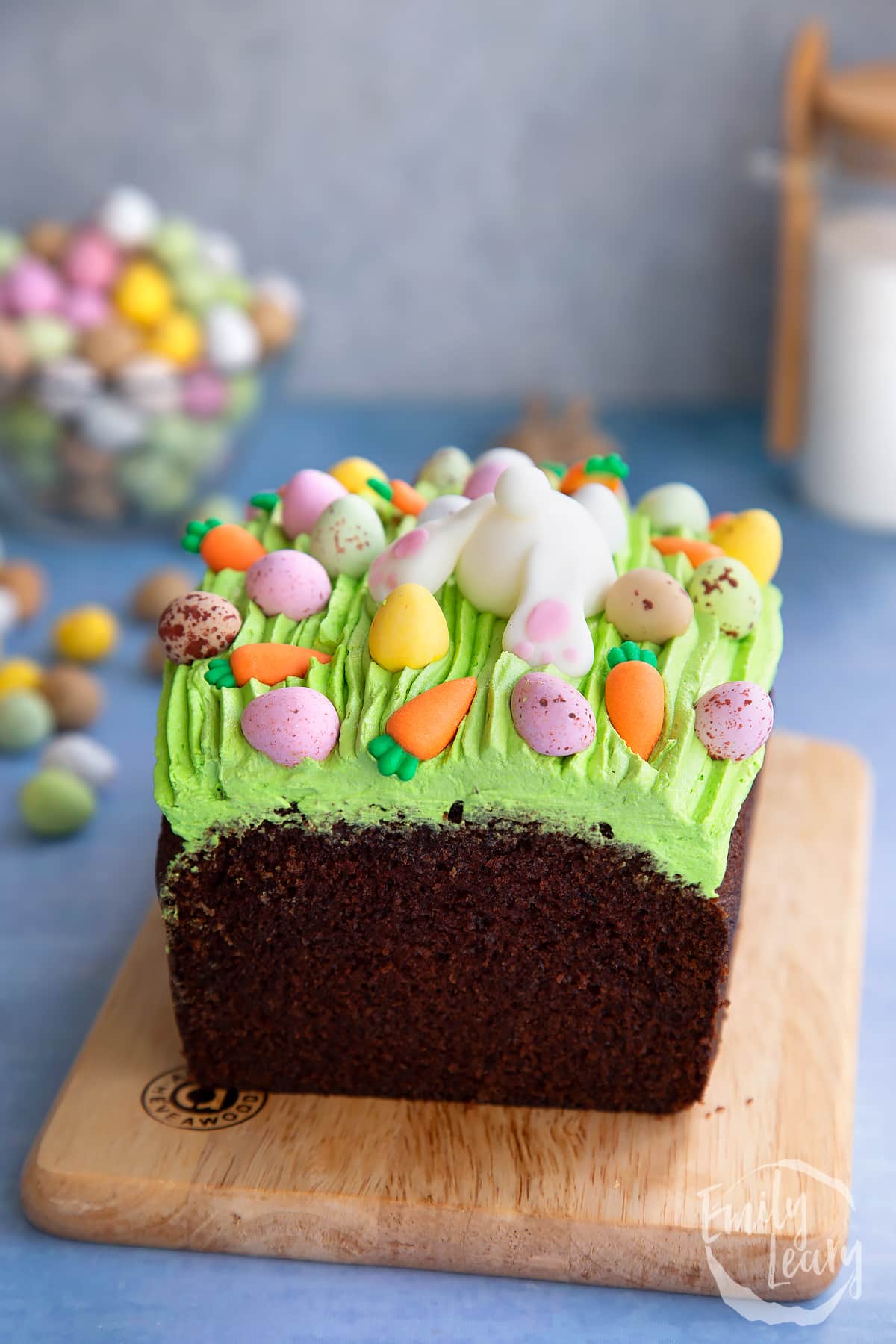
And despite a really beautiful appearance, this Easter loaf cake is really, very easy to make!
The chocolate sponge batter is made using my favourite two-step method. Step one, whisk sugar, beaten eggs, oil, milk and golden syrup. Step two, whisk in flour, cocoa and bicarbonate of soda. And that's it! You'll have a beautiful chocolate cake batter, ready to bake.
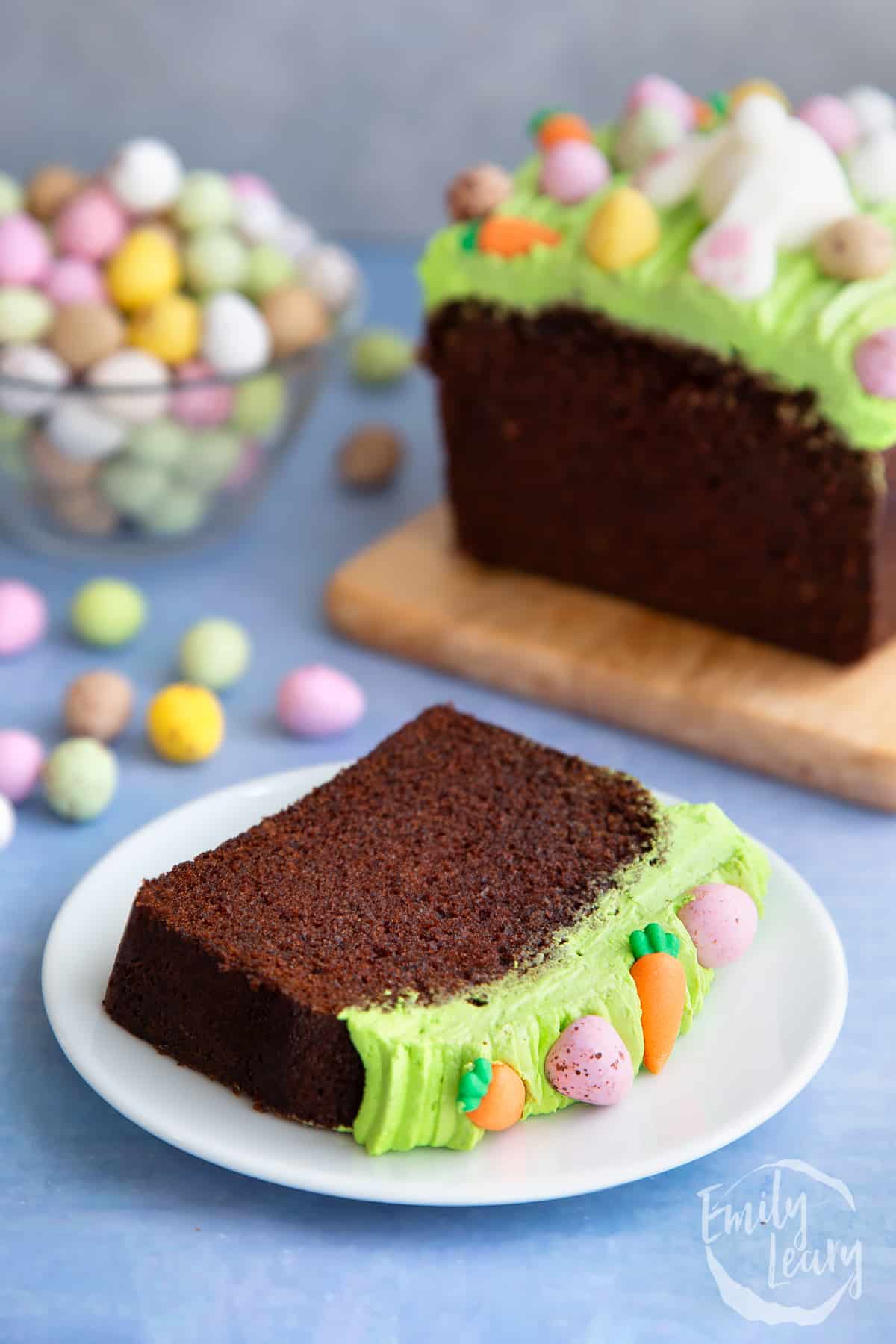
The green buttercream "grass" is even simpler to make. You'll whisk butter, icing sugar, vanilla and a dash of milk together until beautifully fluffy and light, then whisk in just enough green food colouring to get the perfect spring meadow shade.
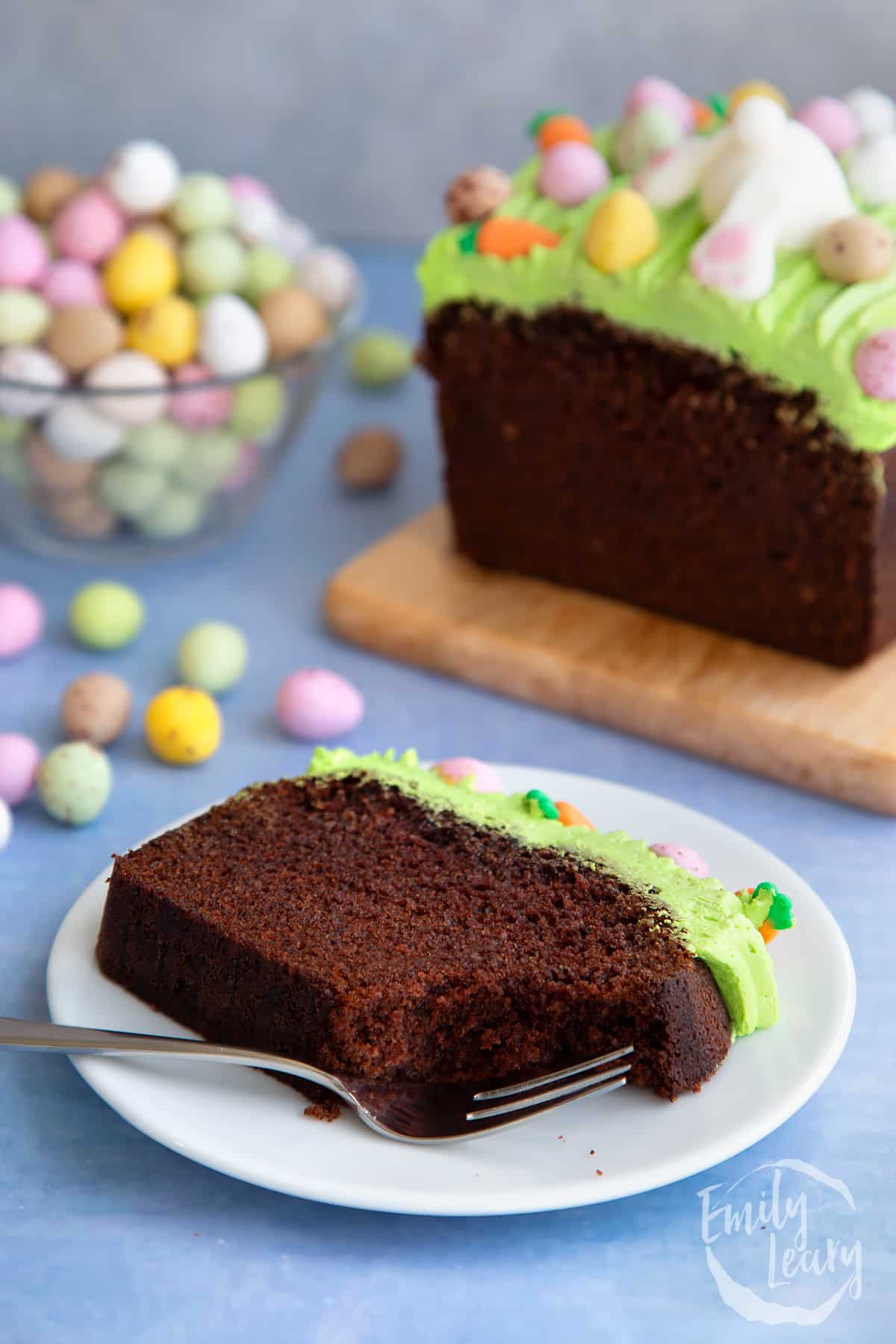
The decorations are simple store-bought carrots made of icing, multicoloured mini eggs, and a super cute burrowing bunny made from white fondant. I've included tips below to make your own bunny butt!
I think you're going to love this chocolate Easter loaf cake. Read on for the full recipe, plus lots of step-by-step photos to help you along the way.
Ingredients
For the chocolate sponge
- 150 g (½+⅓ cup) white caster sugar (superfine sugar)
- 2 medium free range eggs beaten
- 150 ml (½ cup + 2 tbsp) vegetable oil (canola oil)
- 150 ml (½ cup + 2 tbsp) whole milk
- 2 tbsp golden syrup
- 175 g (1¼ cup) self-raising white flour (self rising flour)
- 2 tbsp cocoa powder (dutch processed)
- 1 tsp bicarbonate of soda (baking soda)
For the buttercream
- 200 g (1½ cups + 1 tbsp) icing sugar (powdered sugar)
- 100 g (7 tbsp) slightly salted butter
- ½ tsp vanilla extract
- 2 tsp whole milk
- Green food colouring
For the bunny butt
- 100 g (3.5 oz) white fondant icing
- Pink food colouring
To decorate
- Edible carrot decorations
- 80 g (3 oz) Mini Eggs
Instructions
Make the cake
Preheat oven to 180ºC (160C fan assisted).
Grease and line a medium loaf tin.
Put the sugar, beaten eggs, oil, milk and golden syrup in a large bowl.
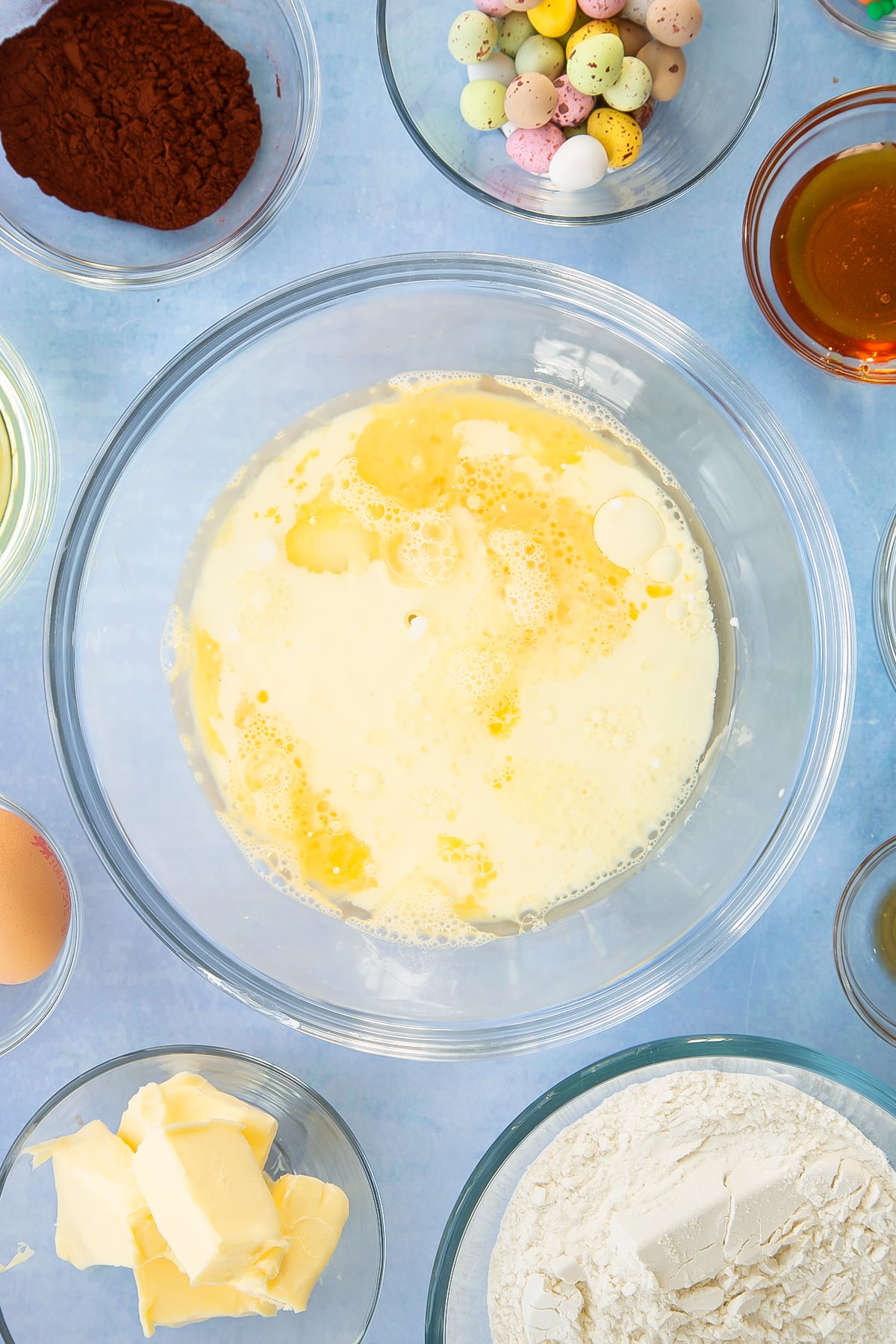
Whisk together.

Sift in the flour, cocoa and bicarbonate of soda.
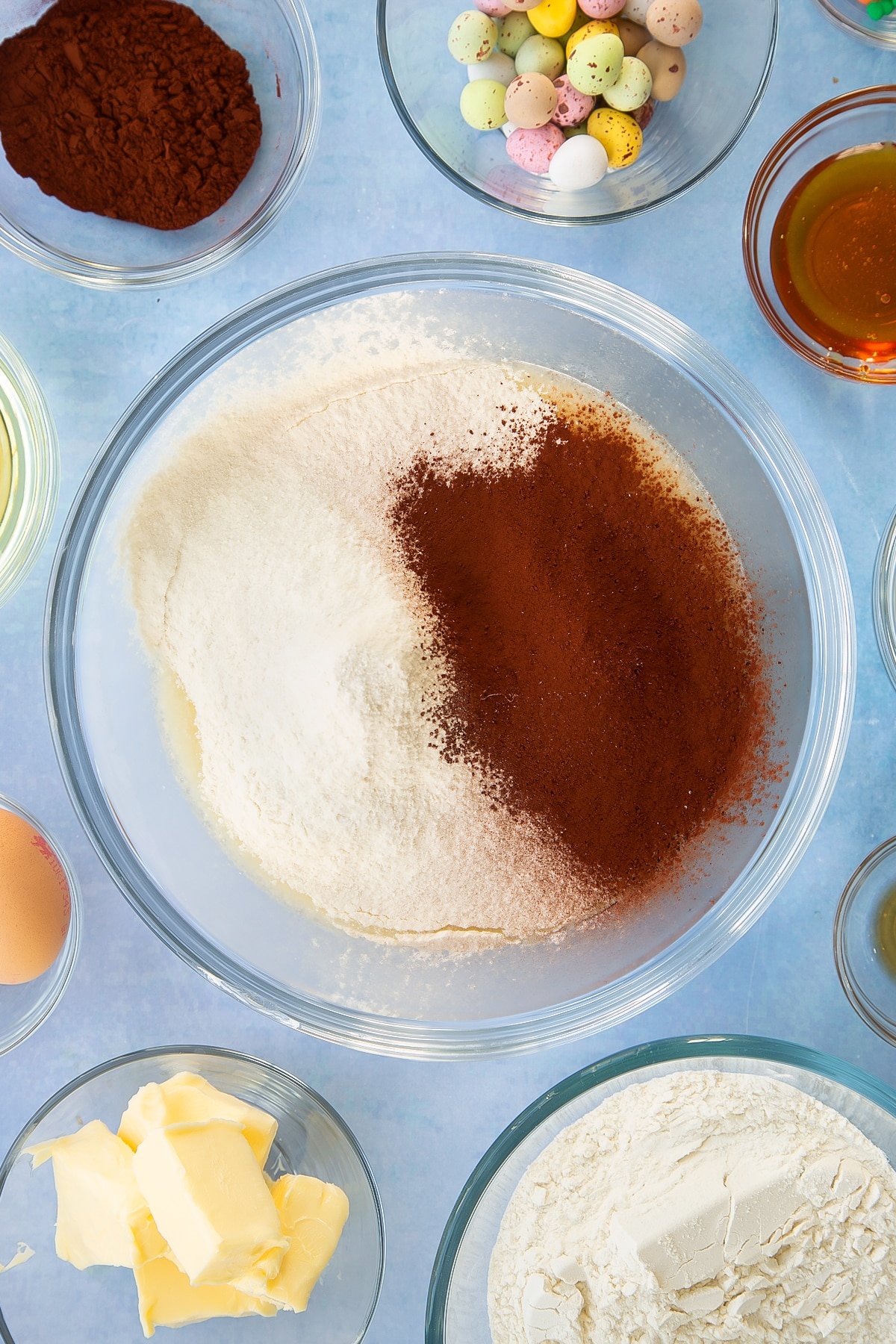
Whisk briefly to combine.
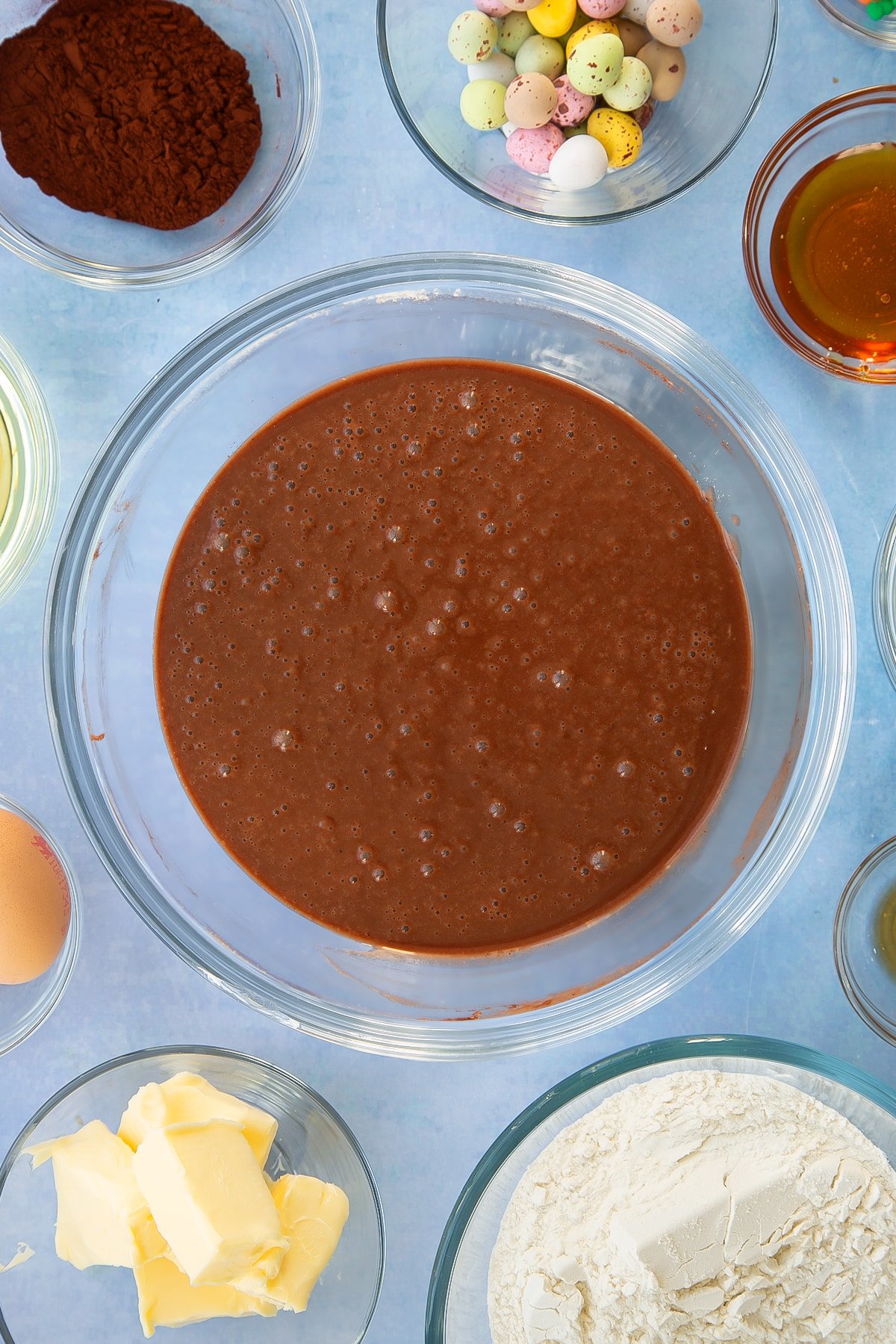
Pour the mixture into the loaf tin.
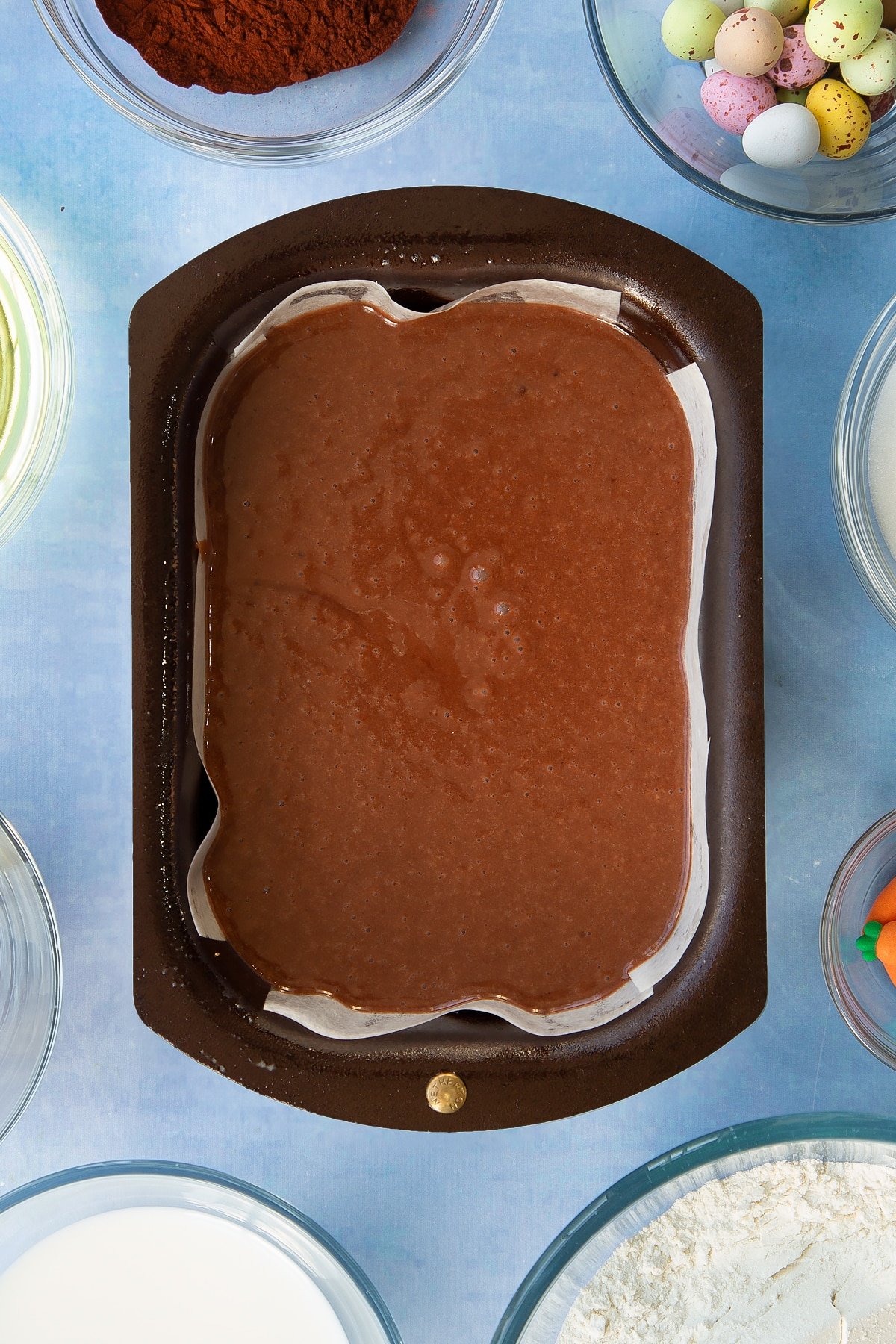
Bake for approximately 45 minutes until firm and springy on top. Cool in the tin for 10 minutes, then remove from the tin and place on a cooling rack to cool completely.
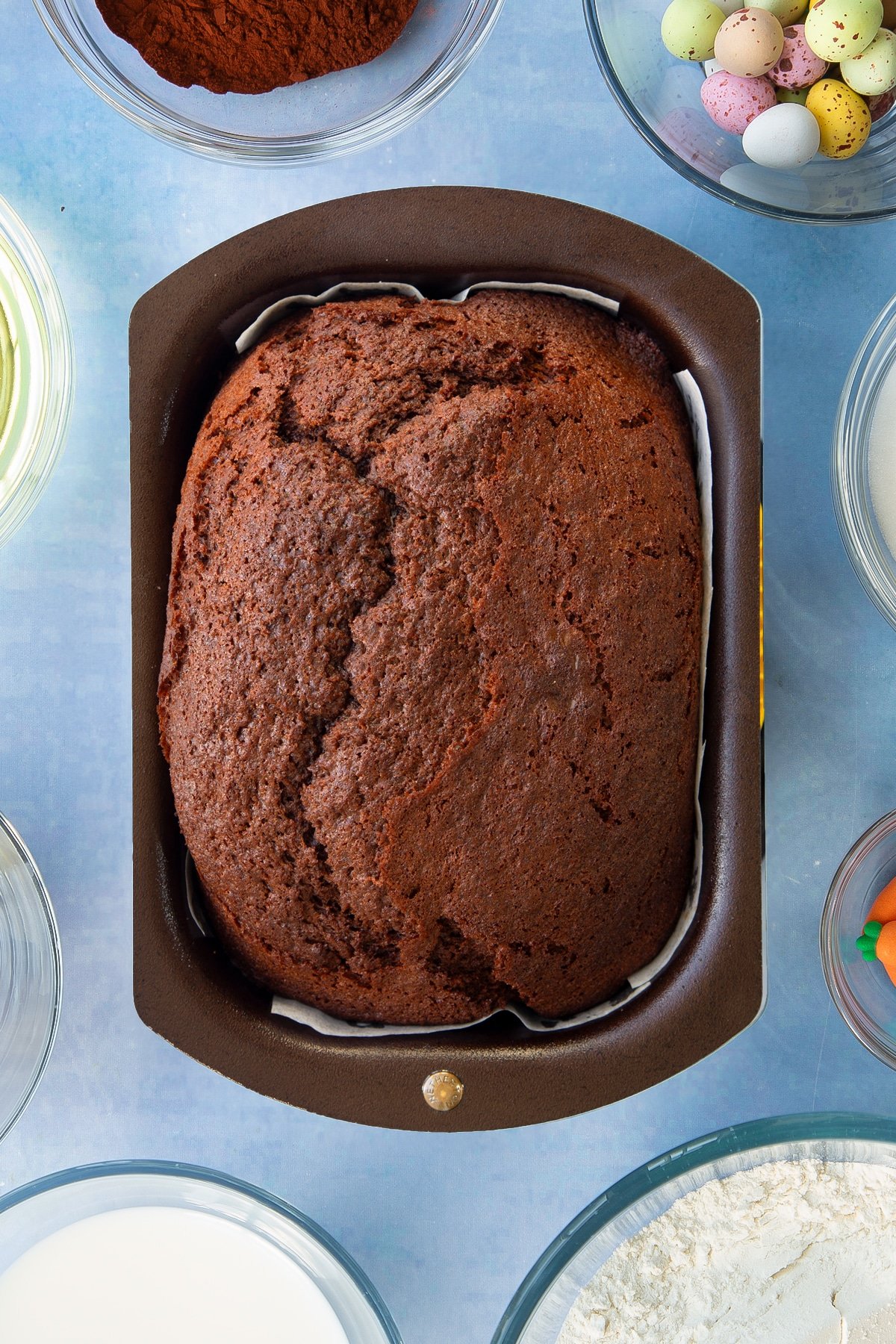
Make the buttercream
Put the icing sugar, butter, milk and vanilla in a bowl.
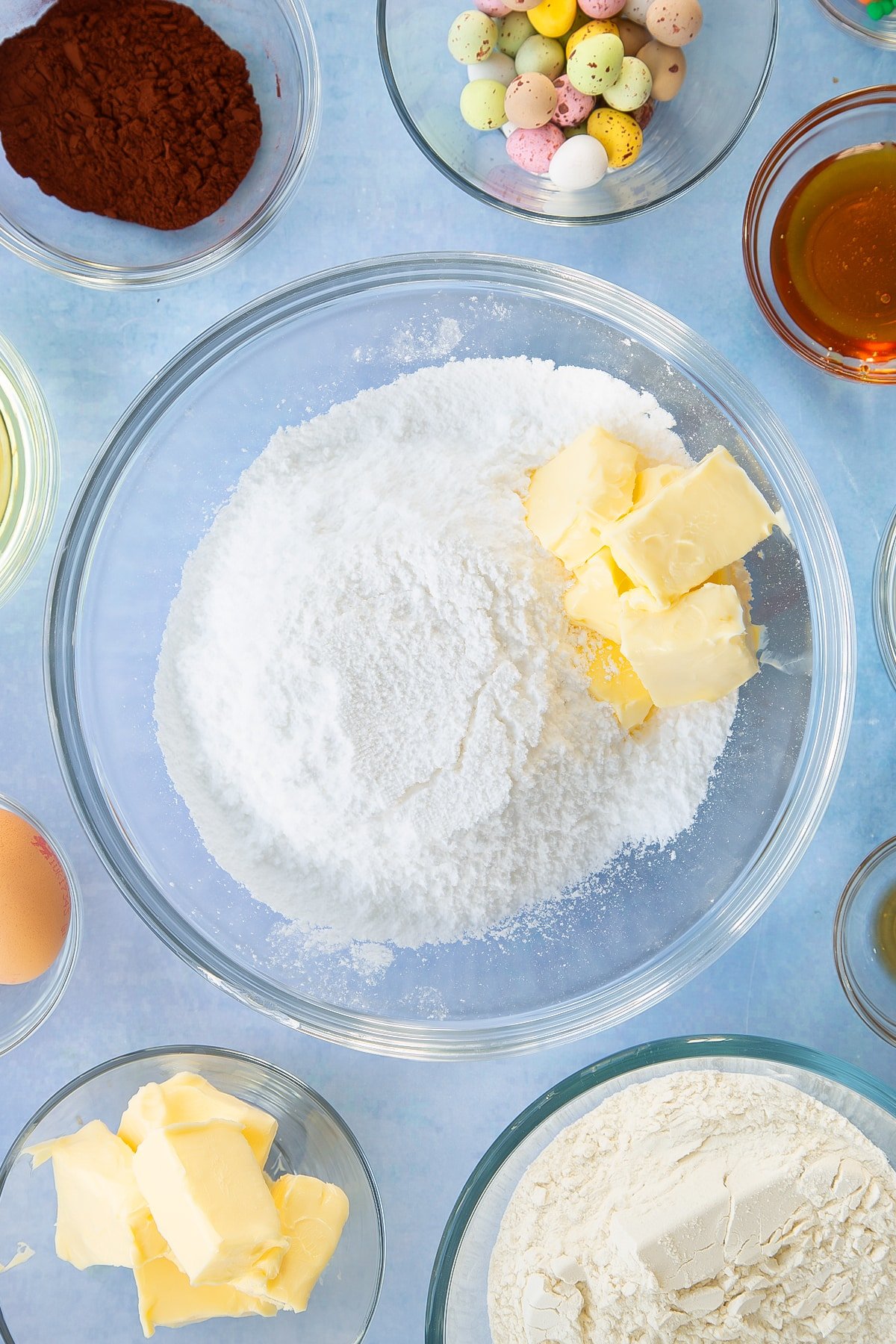
Whisk until light and fluffy.
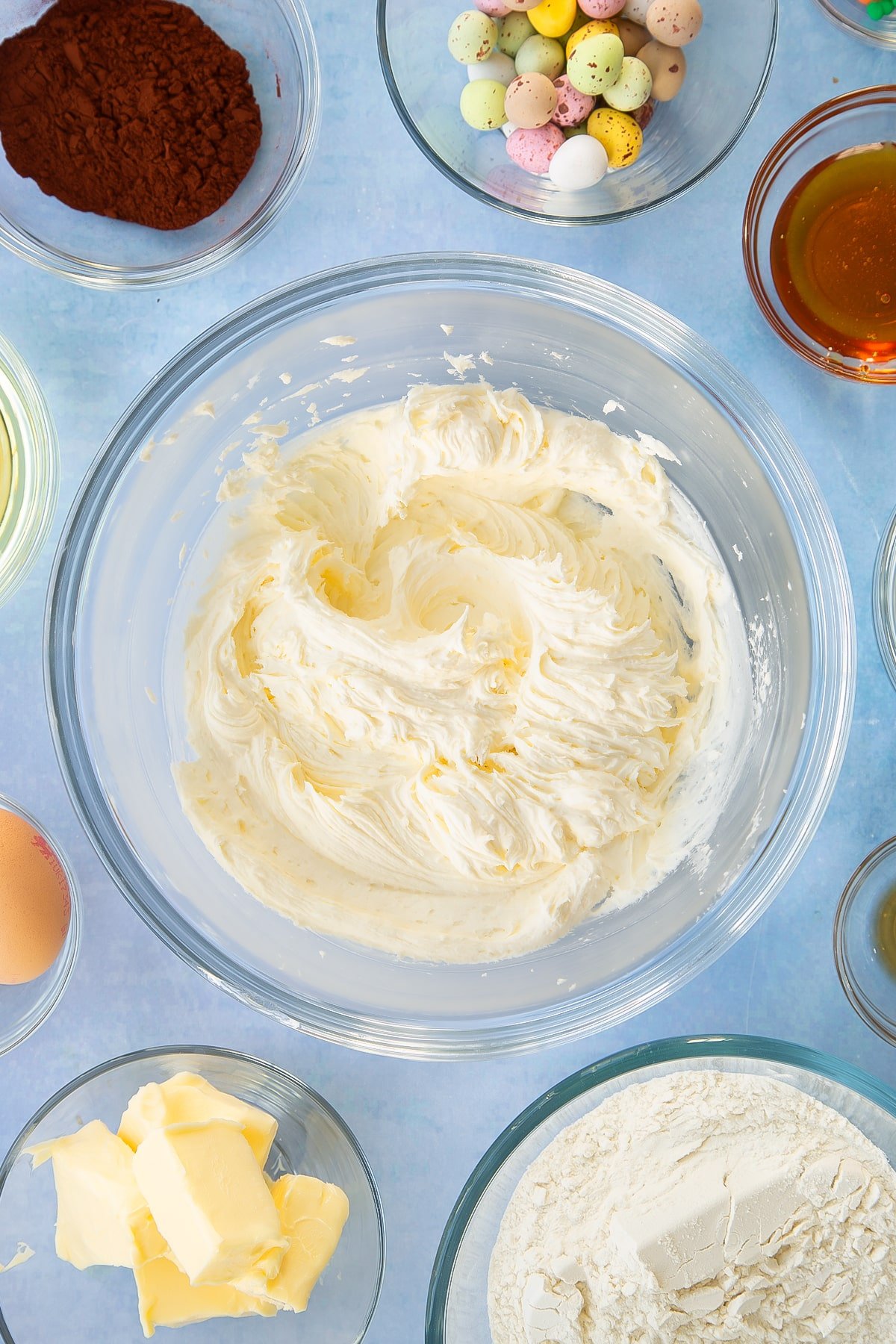
Add a drop of two of green food colouring.
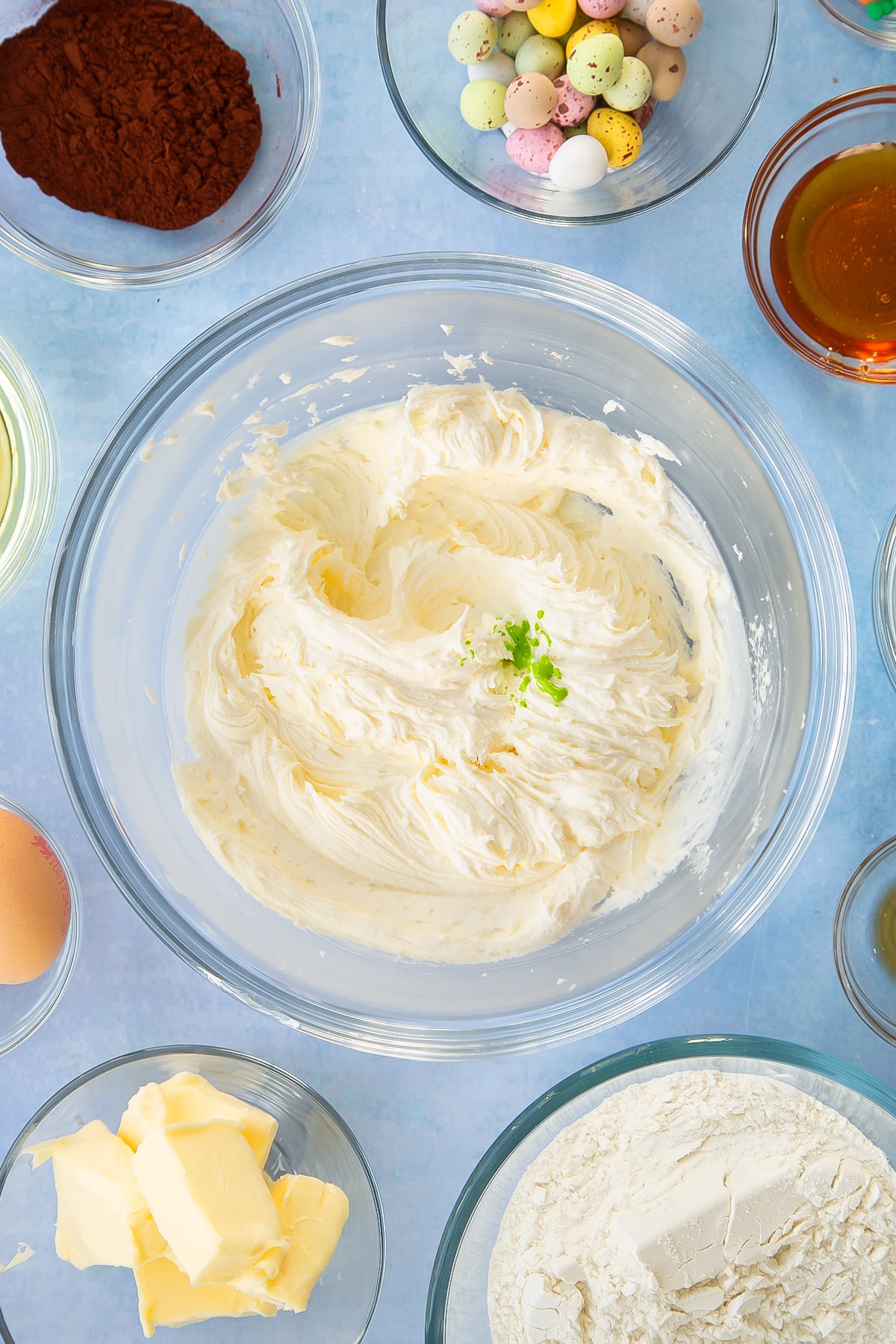
Whisk again, adding more if necessary to get your desired shade of green.
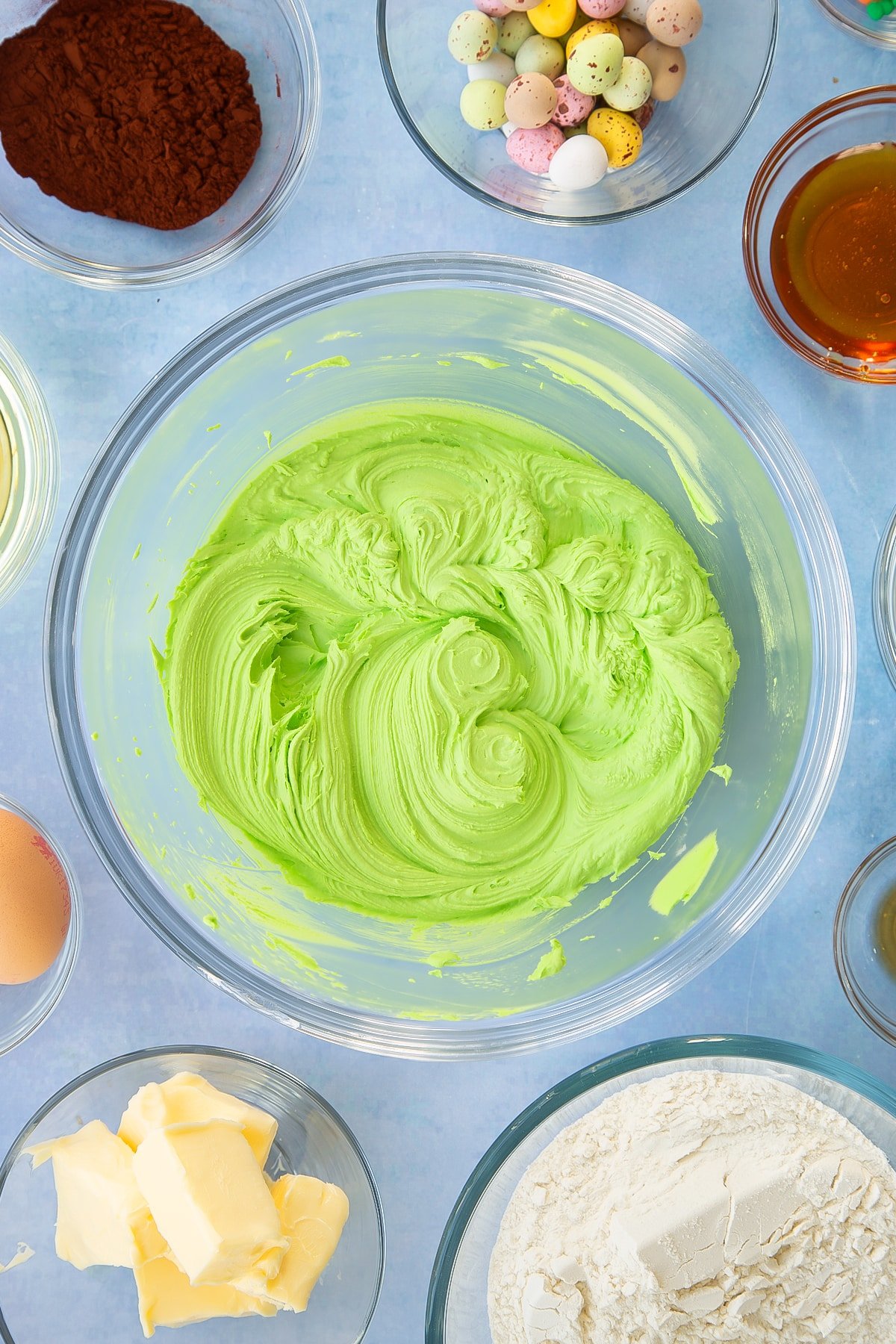
Transfer the buttercream to a piping bag fitted with an open star nozzle.
Place the cooled chocolate cake on a board.
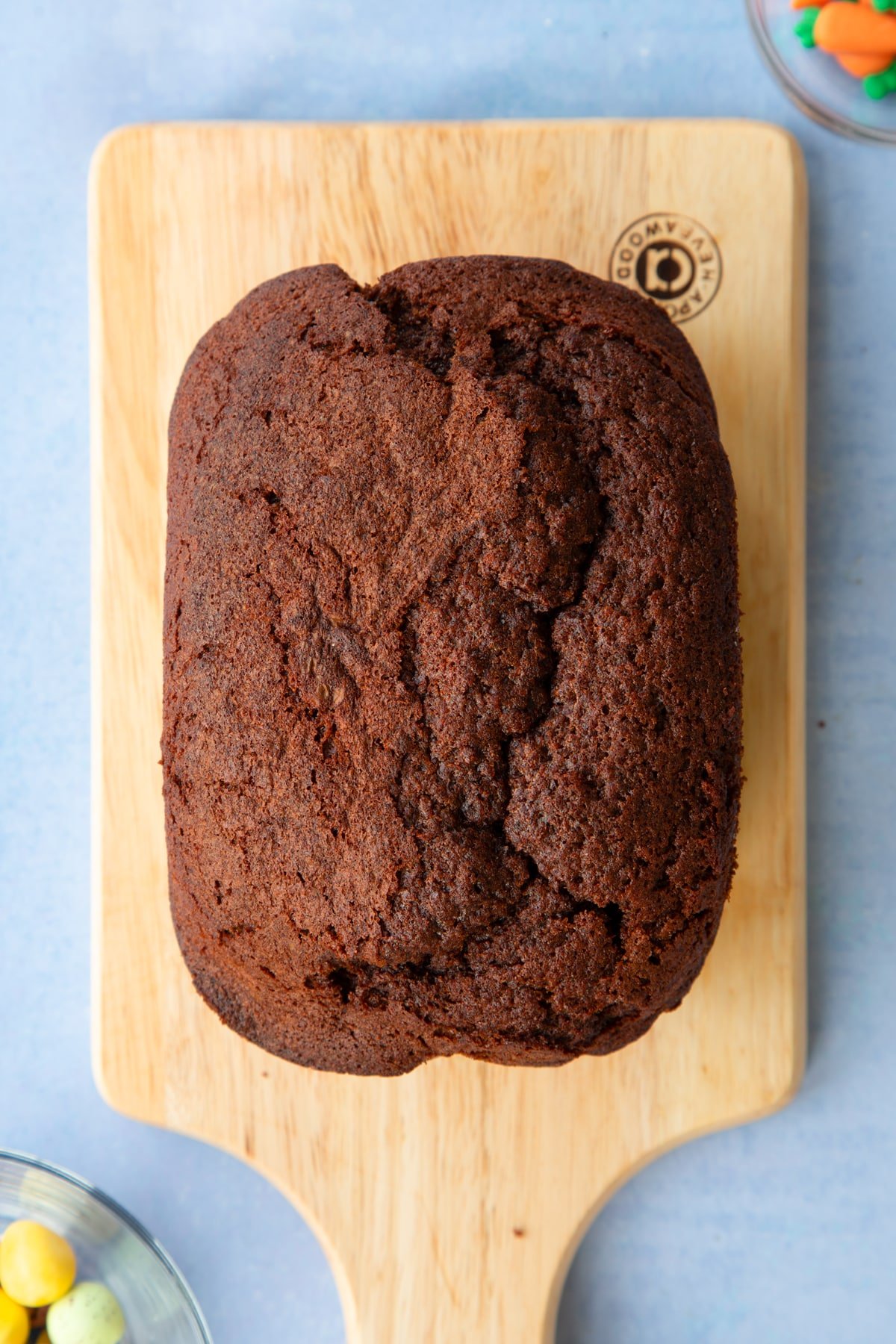
Pipe the buttercream in long lines on top of your cake.

Make the bunny butt
To make the bunny butt, first make a ball of white fondant for the body.
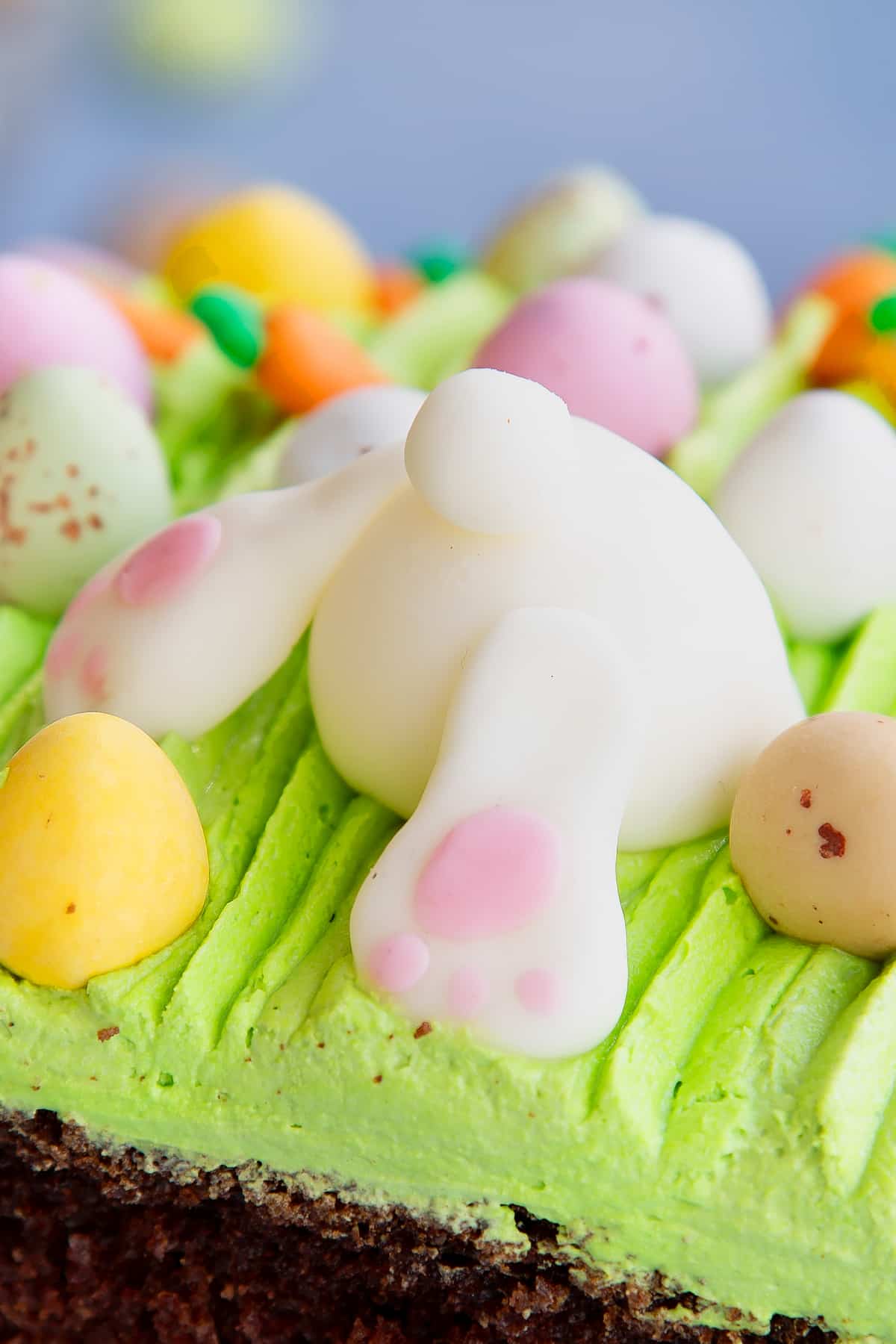
Now make two feet (each a little like the shape of a steak) and stick to the bunny’s body with a dab of water. Add a tiny ball of white fondant for the tail.
Finally, colour a tiny ball of white fondant with a dot of pink colouring and use to give pad detail to each of the bunny’s feet.
Decorate
Place the bunny butt on top of the cake, the scatter the edible carrot decorations and mini eggs all over.

Slice to serve.
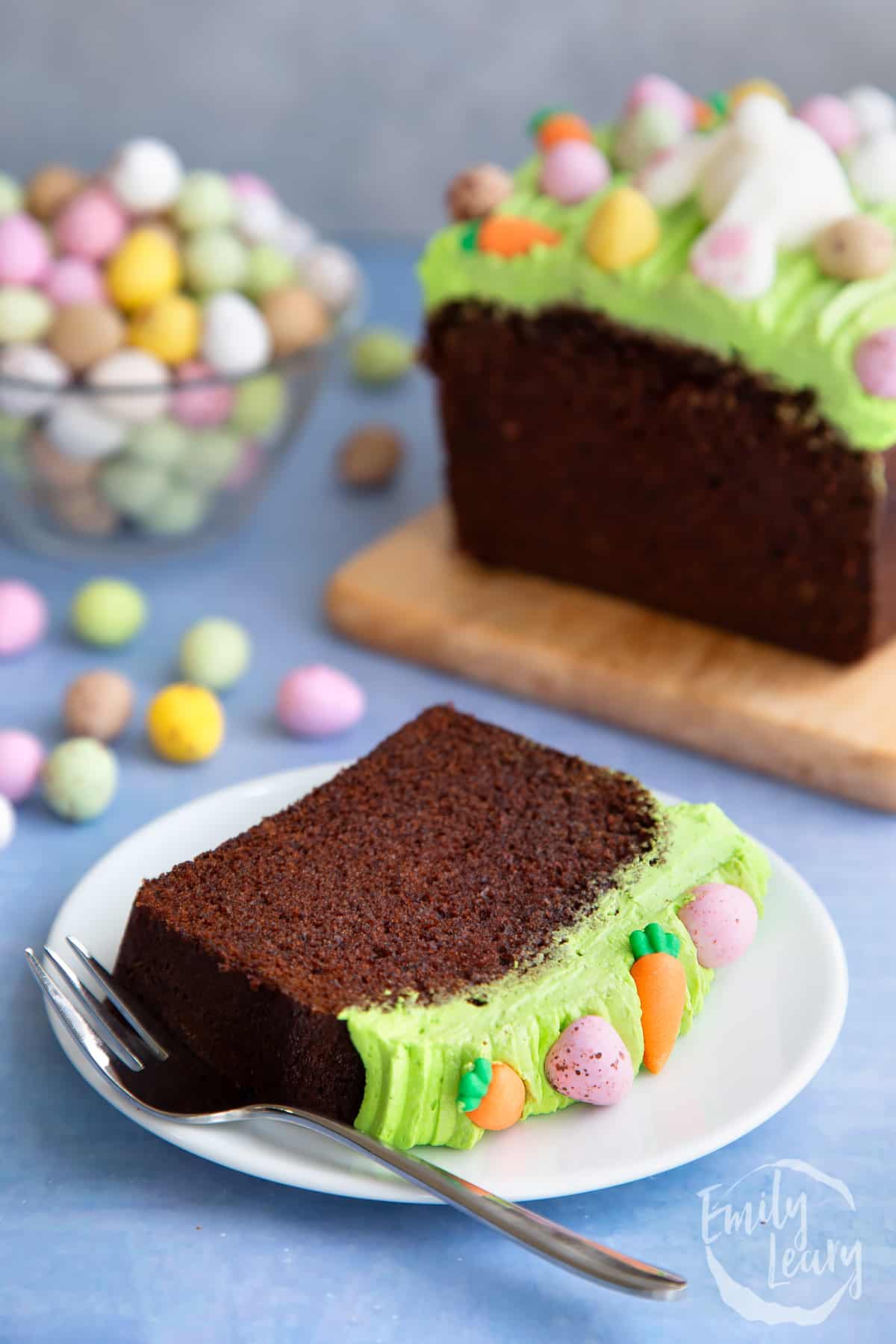
Enjoy the tender chocolate crumb and silk vanilla frosting!
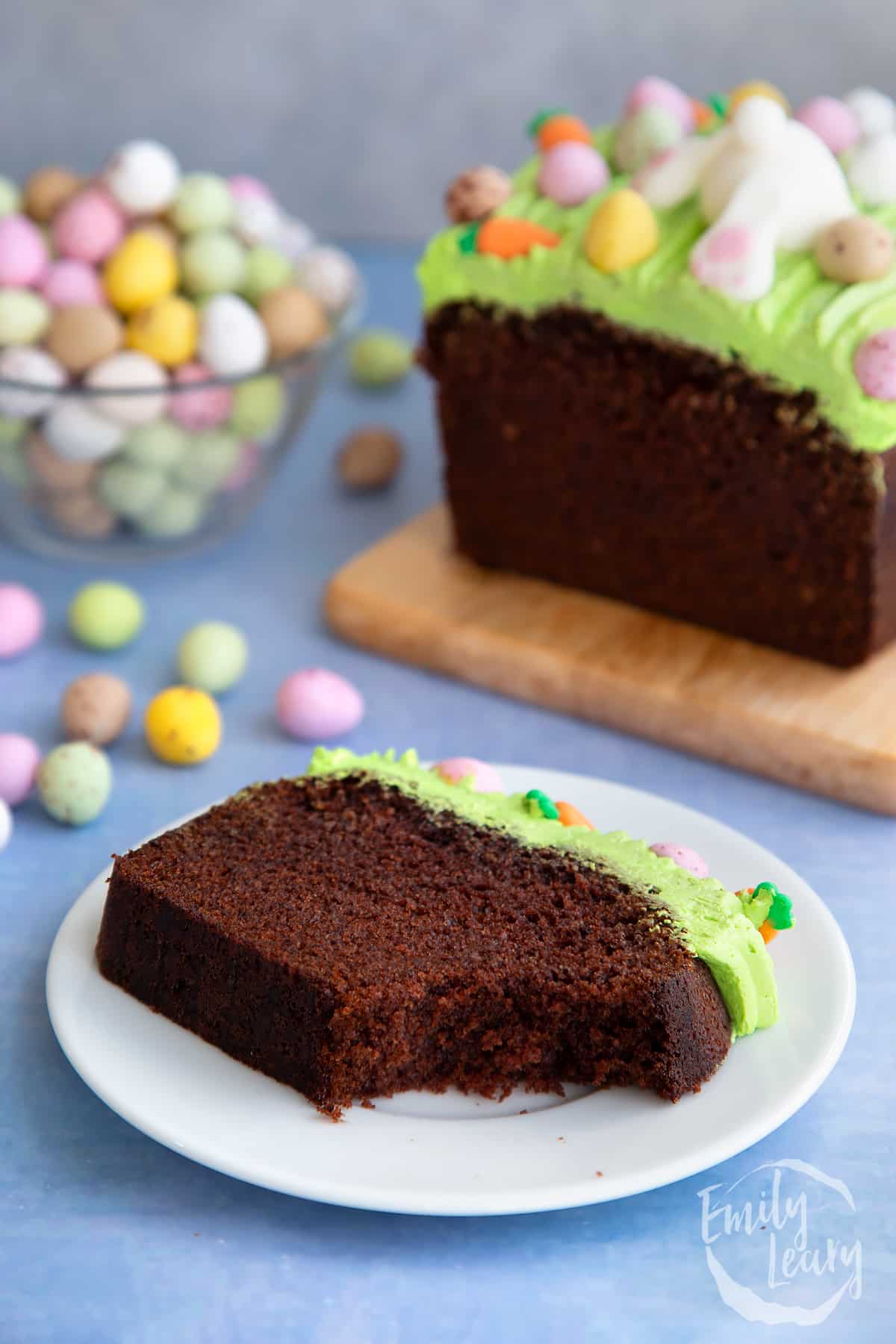
Pointers, tricks and troubleshooting tips for the perfect Easter loaf cake
Is Easter loaf cake easy to make?
Considering how much of a showstopper this recipe is, it's actually super easy to put together! The loaf cake base is a simple sponge recipe that only takes a few minutes to mix. It also takes less than an hour to cook. The recipe is even butter-free - so there's no need to cream butter and sugar together!
Once your loaf cake is cooked, you can leave it to cool while you mix some buttercream frosting with food colouring. And if you have an electric whisk, that means you can make the frosting within a couple of minutes!
The only part that requires more focus is making the fondant icing into your bunny butt. Luckily, fondant icing is just like Play-Doh, so you could even let the kids make their own decorations!
Will I need any special equipment to make Easter loaf cake?
There's always a complete list of suggested equipment on the recipe card below my recipes if you're in doubt. I always include links to example products, so you can see exactly what I used to make each recipe.
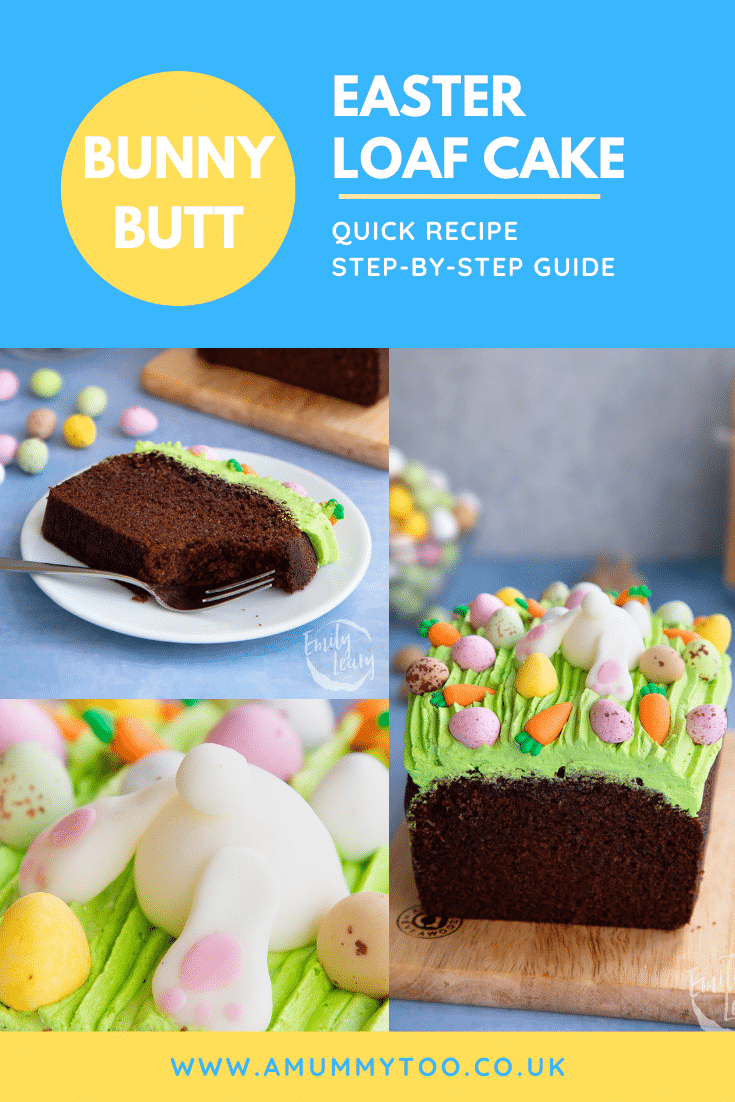
How can I tell if eggs have gone off?
It's always best to cook with fresh eggs because they can behave differently as their quality declines. Older eggs act differently because they lose water content over time, meaning an older egg will be thicker. So not only is it safer to use fresh eggs, but it will improve the quality of your food.
You should never eat an egg that looks, smells, feels or tastes odd in any way. So if your egg has any discolouration or a strange or foul odour, it's most likely rotten.
If your egg has spoiled, you should immediately throw it away and thoroughly wash any pots and utensils that have come into contact with it.
How can I tell if my butter has gone off?
If your butter is fresh, it will be a nice, even cream or pale yellow colour; it should be firm and only have a delicious buttery smell. So it's usually easy to tell if your butter has spoiled as soon as you open the packet. When butter spoils, it turns dark yellow with translucent patches.
Spoiled butter can also appear to 'sweat' as the bonds between fat, protein and water molecules are broken down by bacteria.
The lactic acid released will also generate a sour smell and cause the butter to taste fizzy or tangy.
Sometimes spoiled butter can look completely fine, so you should taste it before including it in a recipe. If it tastes fizzy, you'll know it isn't safe to use.
It's best to keep butter in the fridge as it will spoil if it isn't kept somewhere cool or left exposed to the air. So you should always keep butter sealed in the refrigerator.
What is fondant icing?
Fondant icing is a form of icing which contains glucose syrup. The glucose gives it a malleable texture, similar to Play-Doh - so it's perfect for decorating cakes and bakes.
Fondant icing is pretty forgiving as it's so malleable, and it stays soft. So if you make any mistakes, you can reform your bunny or start again very quickly!
Where can I buy fondant icing?
Fondant icing is a cake decorating staple, so it's available on the baking aisle of most supermarkets.
If you can't find any in-store, you can find fondant icing on Amazon or from specialist online cake decorating retailers.
Can I use sugar paste instead of fondant icing?
Feel free to use sugar paste if you can't find fondant icing. Sugar paste is very similar to fondant icing, but there's one key difference: Sugar paste sets hard, whereas fondant icing will stay soft.
For this recipe, the way sugar paste dries is no issue, so feel free to use sugar paste if it's all you can find.
Sometimes brands will use the terms fondant/sugar paste for the same product, so there's very little difference between the two.
Where can I buy edible carrot decorations?
Edible carrot decorations are actually relatively easy to find in supermarkets - as they're a common decoration for carrot cake.
Many supermarkets have their label versions on the baking aisle, alongside things like cake sprinkles. Or, if you can't find edible carrot decorations in the store, you can always find them on Amazon.
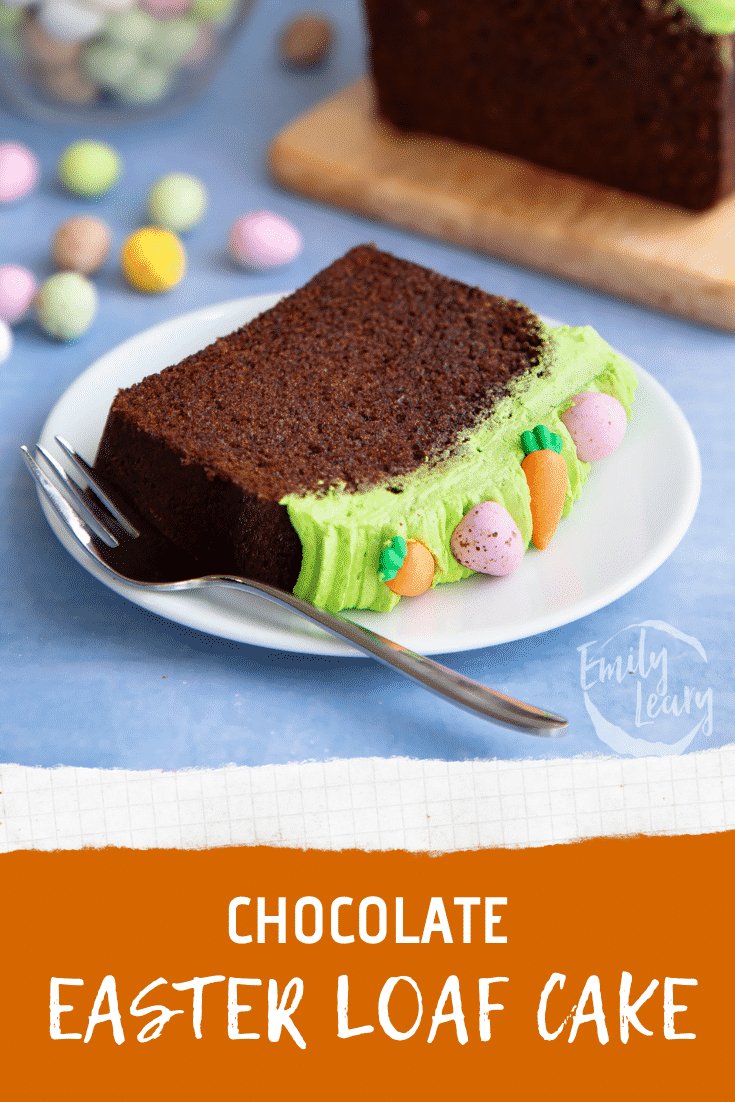
Is this Easter loaf cake suitable for vegetarians?
Yes, this recipe is entirely vegetarian. However, one ingredient to watch out for is food colouring.
Some food colourings use animal-derived ingredients for their colour, so just make sure you use a vegetarian brand of food colouring, and vegetarian carrot decorations and your cake will be safe for veggies!
Animal-derived products can also be used to thicken or flavour sweet food -meaning it can sneak into the most surprising ingredients!
So always make sure that you double-check all of your ingredients labels to ensure that they're vegetarian. Also, don't forget to check anything extra that you intend to serve with your recipe.
Is this Easter loaf cake suitable for vegans?
This Easter loaf cake isn't vegan as it contains dairy and eggs. Don't worry, though! It should be easy enough to adapt for a vegan, as you'll only need to swap out 4 ingredients.
Luckily, as of February 2022, vegan alternatives to egg and dairy are available in most supermarkets worldwide. So you'll be able to swap the dairy and egg for vegan options pretty easily!
Vegan butter:
To make the frosting for your Easter loaf cake, you'll need to use vegan butter instead of dairy butter.
You should find vegan butter with a fat content of around 80% so that it behaves similarly to dairy butter when it's mixed. If it has a low-fat content or it's very soft, it might not mix into a substantial buttercream.
Many brands in the UK and worldwide offer vegan alternatives to butter, including Flora, Naturli and Violife.
Though if you can't find those brands, plenty of supermarkets have their own label versions of vegan butter - so keep your eyes peeled on the refrigerated aisles.
I mainly use unsalted Flora vegan butter in vegan baking. However, the frosting recipe calls for slightly salted butter, so make sure you find a plant-based salted butter or add a little salt to compensate.
Vegan milk:
You can replace the milk in the Easter loaf cake and the frosting with any plant milk of your choice. I generally use unsweetened soya milk for vegan baking, as I find it to be the most neutral flavour and stable.
It's important to note that some brands or varieties of plant milk can split or curdle when used in cooking, so you may need to experiment. Overall, oat milk and unsweetened soya milk tend to perform best in cooking.
Some brands of plant-based milk use sweeteners, so make sure you don't buy sweetened plant milk.
Finally, many brands fortify their plant milk with vitamins, minerals, and other ingredients that could impact their cooking performance, so look out for that on the labels.
Egg replacer:
Next, you'll need to replace the eggs will need with one of the following options (each = 1 egg, so multiply as needed for any given recipe):
- 3 tablespoons of aquafaba. Aquafaba is the water you get in a tin of chickpeas, and no, it doesn't taste like chickpeas!
- 1 tablespoon of crushed chia seeds or flax seeds mixed with 2 tablespoons of water and left for 10 minutes in the fridge.
- 3 tablespoons of applesauce (bear in mind this will add sweetness and potentially an apple flavour).
Food colouring:
Most food colouring is vegan friendly, but some brands still use animal-derived products. So keep that in mind if you're adapting this recipe for a vegan friend!
Chocolate eggs:
Finally, you'll need to replace the Cadbury Mini Eggs with vegan alternatives. Doisy and Dam are a vegan chocolate brand that makes vegan dupes of well-loved dairy chocolate classics. And luckily, they have vegan Mini Eggs in their range!
However, as with most vegan chocolate, their eggs contain darker chocolate than Cadbury's Mini Eggs, so keep that in mind if you use them.
If you're making these cupcakes for someone with dietary requirements, you should make sure you check the ingredients for any sides or decorations.
Is this Easter loaf cake gluten-free?
This Easter loaf cake recipe isn't gluten-free, but you can adapt it for a gluten-free diet pretty easily.
The only ingredient containing gluten is the self-raising flour, so you just need to swap the flour for a gluten-free flour blend and follow the recipe as it states. Some gluten-free flours can struggle to rise as well as wheat flour, so it's best to use a gluten-free flour blend. A blend will contain several ingredients which help mimic the behaviour of gluten.
Double-check all of your ingredients, labels to make sure that they are gluten-free. Don't forget to check anything extra you intend to serve with your Easter loaf cake.
Is this Easter loaf cake keto-friendly?
This Easter loaf cake recipe is decidedly unfriendly to those on a ketogenic diet. The recipe calls for carbs and sugar, which are unsuitable for a keto diet. So, unfortunately, this recipe isn't suitable for adapting with keto ingredients either.
Is this Easter loaf cake healthy?
This Easter loaf cake is pretty high in fat and sugar, so it's best enjoyed as a seasonal treat. Remember - treats are fine, as long as they're enjoyed in moderation and as a part of a healthy, varied diet.
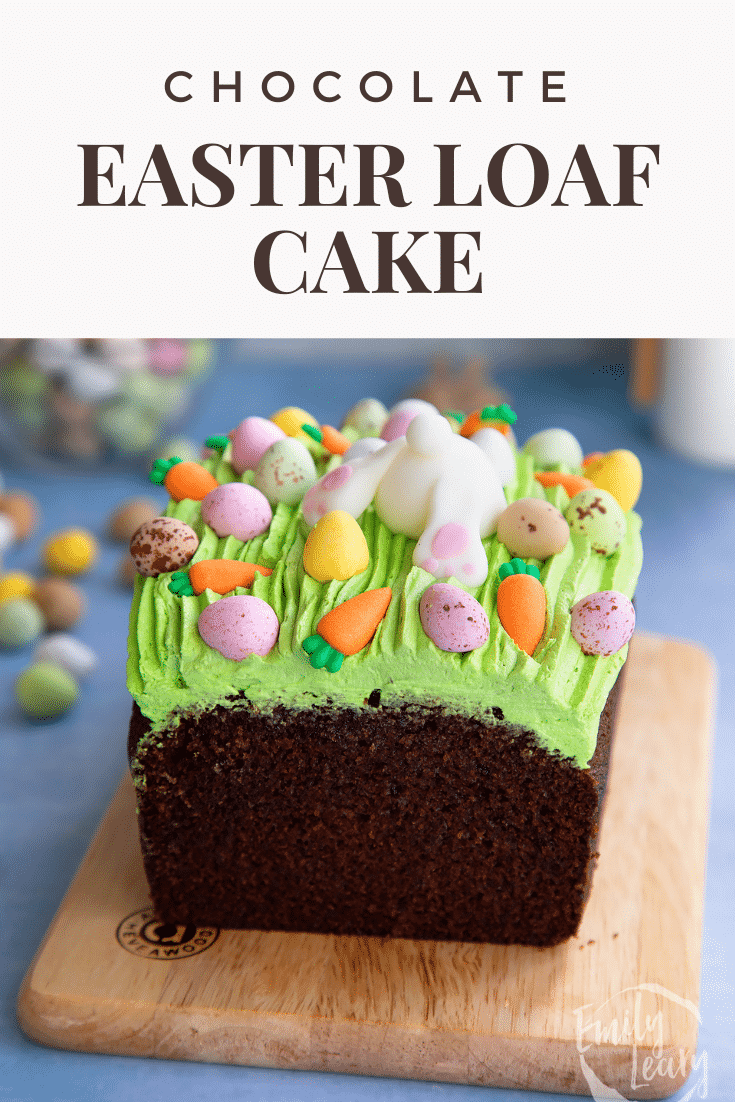
Is this Easter loaf cake safe to eat while pregnant?
There's nothing in this recipe that would be considered risky for someone who is pregnant. Though it's important to note that this recipe does contain a lot of sugar.
Some pregnant people can be more susceptible to changes in their blood sugar. So consult your doctor if you're concerned about eating sugary foods during pregnancy.
When cooking for someone who is pregnant, you should take extra care to make sure that all of your ingredients are in good condition and this meal is prepared safely and hygienically.
A Mummy Too does not offer medical advice. Please seek help from a medical professional if you need further information or have any concerns.
What goes well with Easter loaf cake?
This Easter loaf cake has a moist texture and deep chocolatey flavour. So some cream or ice cream might work well to cut through some of the richness. That said, the cake will be perfect on its own too, as it is so moist and moreish!
Can I make this Easter loaf cake without food colouring?
You can make your Easter loaf cake without food colouring, but you'll end up with a very plain white-topped cake. However, if you wanted to make a loaf cake over Christmas, you could turn your Easter loaf cake into a Snowman loaf cake!
Can I add extra chocolate to this recipe?
You can add extra chocolate to your Easter loaf cake, in the batter or for decoration.
The sponge part of this Easter loaf cake gets its chocolate flavour from cocoa powder in the batter. So if you want some extra chocolate in the cake, a handful of chocolate chips through the cake batter would work really well without changing the bake time too much.
The top of the cake is decorated with some chocolate filled Mini Eggs, but feel free to add as many chocolate eggs as you like for decoration.
How should I store my Easter loaf cake?
This Easter loaf cake is decorated with buttercream frosting, so it needs to be refrigerated or kept in a cool pantry if you live in a colder climate.
If you leave butter at room temperature, it will melt and spoil within a few hours. So you should pop it into an airtight container and refrigerate it when it isn't being served.
How long will the Easter loaf cake keep?
Your Easter loaf cake should stay lovely and moist and safe to eat for up to 5 days if kept in the fridge.
You can freeze your cake to prolong its life, but bear in mind that your frosting may split when it defrosts, and the decorations will most likely change colour or shape. If you freeze your cake, it should keep for up to 3 months.
Can I leave my Easter loaf cake out on the counter?
You can leave your Easter loaf cake out on the counter for up to an hour while serving, but it needs to be stored in the fridge because of the buttercream frosting.
Can I make my Easter loaf cake ahead?
Yes, this recipe is great for making ahead - as long as you store it in separate pieces. I find it's best to make the loaf sponge and refrigerate or freeze it undecorated. It will keep in the fridge for up to 5 days or, if you freeze it, up to 3 months. If you need to defrost your loaf cake, just pop it into the fridge overnight the day before you want to serve.
You can also make your buttercream ahead of time and keep it in the fridge for up to 4 days. Or you can freeze your buttercream for up to 3 months. It only takes around 2-4 hours to defrost a bowl of frozen buttercream, so you can take it out of the freezer the day you plan to assemble your cake.
Once your buttercream is defrosted, give it a quick mix to get it back to its lovely smooth texture, then decorate your defrosted or refrigerated loaf cake sponge as the recipe states.
You shouldn't make your bunny butt ahead; if you freeze it, the food colouring will run when it defrosts. Or it will most likely dry out within a couple of days in the fridge. Luckily it only takes a few minutes to make the bunny butt so that it won't add extra time.
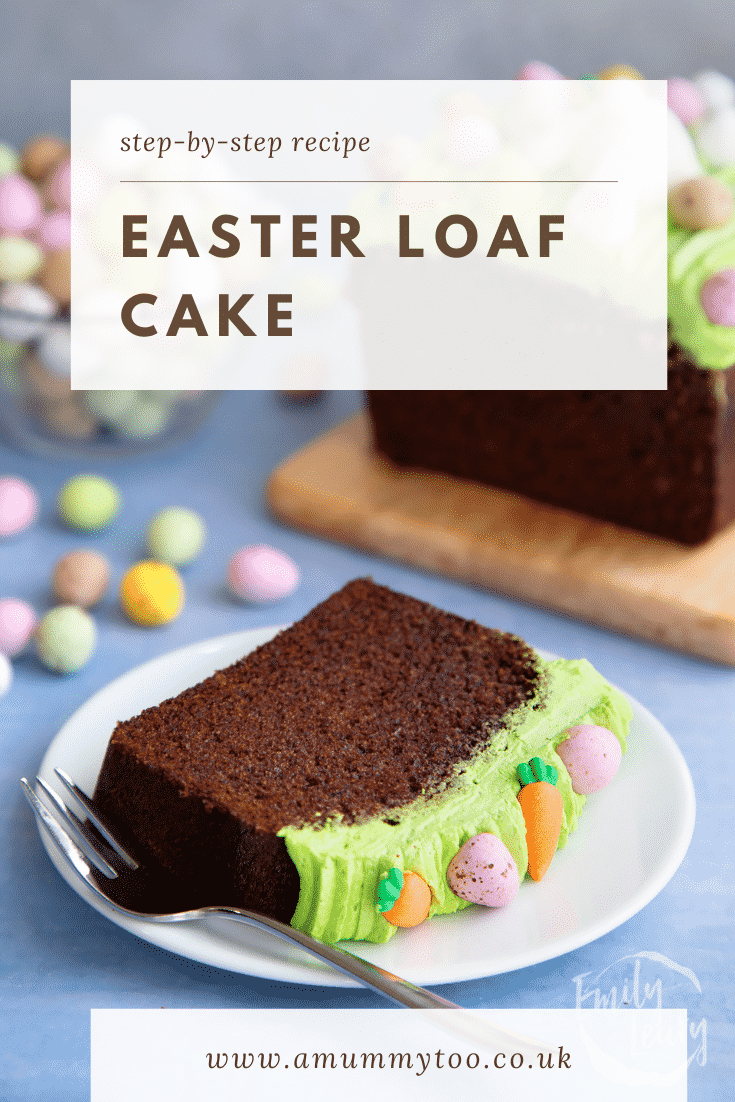
Can I keep my Easter loaf cake in the refrigerator?
Yes, the best place to keep your Easter loaf cake is in the fridge. However, make sure you store your loaf in an airtight container, so it remains protected from any contamination or 'fridge smells'.
Your cake will stay fresh and edible for up to 5 days if stored correctly, though, over time, the bunny butt and Mini Eggs might become soggy or absorb the green colour from the buttercream frosting.
Can I freeze my Easter loaf cake?
Yes, you can freeze your Easter loaf cake in a few ways.
First, as I mentioned above, you could freeze your Easter loaf cake undecorated by wrapping the loaf sponge in cling film (Saran Wrap) or storing it in a lunchbox.
Or, if your cake is already decorated, you can freeze it whole within a lunchbox or airtight container. Just make sure to use the container big enough so that the frosting doesn't touch the sides. Finally, if you want to freeze slices of leftover Easter loaf cake, that's fine. It's also more convenient when you only want to defrost individual portions at a later date. The best way to freeze slices is to space them out in a flat layer on a tray lined with baking paper and freeze them for several hours. T
hen once they're fully frozen, transfer them into a lunchbox, in layers separated between sheets of baking parchment. This process stops the individual slices from sticking together when they freeze.
Note: If you freeze your cake after decorating, the frosting will probably split when it defrosts. Buttercream tends to split because freezing the water in the butter disturbs the bond between fat, water and protein, causing it to separate.
What is the best way to defrost my Easter loaf cake?
The best way to defrost your Easter loaf cake is to transfer it from the freezer into the fridge. It's best to defrost your Easter loaf cake within an airtight container to keep
Can I make Easter loaf cake in a different size?
If you have a different sized cake tin, feel free to make more or less of this Easter loaf cake. The serving sizes for this recipe is in slices, so you can work out how many slices your loaf tin has and change the serving size accordingly.
To do this, just scroll down to the recipe card below. You'll see the serving number near the top of the recipe card. To change this to the number you want to make, just click on it, and a little slider will pop up. You can move the slider up or down to get the amount you want to make. All the ingredient quantities will automatically update you so that everything is in the correct ratios.
If you make a bigger cake, you might need to cook it for a little longer, or if you make a smaller cake, the opposite will be the case.
The cooking time is a guideline, as most household ovens have inconsistent temperatures compared to the one on the temperature dial. So just keep an eye on your cake towards the end of the cooking time to make sure it doesn't overcook or undercook, and use the skewer test to check whether it is cooked through.
Can I make Easter loaf cake in a stand mixer like a KitchenAid or Kenwood Mixer?
A stand mixer would be helpful to mix your cake batter and mix the buttercream frosting. However, if you use a stand mixer, you'll need to ensure that you don't overmix your batter or buttercream.
Before adding the flour and baking soda to the batter, you should stop the stand mixer. Then you should gently fold the flour and baking soda into the batter by hand with a spoon or spatula.
This is because overmixing your flour or raising agents can knock the air bubbles out of the batter and overwork the flour, resulting in a tough cake.
Equally important is not to overmix the buttercream. Overmixing buttercream can cause it to split, as the mixing loosens the butter, which causes the fat and water in the butter to separate.
So don't leave your batter or buttercream unattended in the mixer, as it can overmix both quite quickly.
Can I make Easter loaf cake with a food processor or power blender?
A food processor would be too powerful for this recipe as it would overmix the flour and split the buttercream very easily. It would also be very fiddly to get your batter and buttercream out of your blender, so it's best to mix them in a bowl.
How can I make sure my Easter loaf cake turns out perfectly?
This Easter loaf cake recipe is super simple, as there are only a few ingredients for the sponge, and it takes less than an hour to cook. The decoration looks very impressive, but it's actually quite simple because it's just coloured buttercream and a few decorations added on top.
However, to ensure that your Easter loaf cake turns out perfectly, there are a few steps to watch in the recipe.
Measurements:
To avoid mistakes with ingredients, I always make sure to weigh out my ingredients before cooking so I have all of my ingredients laid out and ready to go when needed. Ensuring that your ingredients are prepared before you begin means that you don't have to worry about working out measurements while cooking, which can be confusing and lead to mistakes.
Preheat your oven:
Before you begin to mix your cake batter, it's crucial to turn your oven on so it's adequately preheated before cooking. If you add your cake into an oven that isn't the correct temperature, it can affect the way the cake rises or cause it not to rise at all. Many domestic ovens have an incorrect temperature dial, which can cause issues with bakes. If this is the case with your oven, an oven thermometer can help. An oven thermometer is a thermometer that you can leave in the oven while it's on, so you can see the correct internal temperature of the oven. You can find oven thermometers in most supermarkets, kitchenware stores, or Amazon.
Mix properly:
Once you begin to mix your cake batter, it's essential to make sure that you add the ingredients in the order that the recipe states. The raising agents react with liquid as soon as they come into contact with it, so if you add your raising agents too quickly, you're at risk of knocking the air out of the cake batter resulting in a tough or flat cake that doesn't rise.
Buttercream:
While your cake is cooking, you need to make your buttercream frosting to decorate it. Buttercream is very simple. It's just icing sugar, a little milk and softened butter. The only points to watch while making buttercream are that you don't overmix your butter and use softened butter, not melted butter. As I said before, overmixing butter or using too soft butter will cause your buttercream to split, so make sure that your butter is still chilled but it's not rock hard.
Why did my Easter loaf cake turn out dry/crumbly?
This recipe uses oil and milk in the batter, which should give you and lovely moist loaf cake sponge. So it should be very hard to dry out your sponge cake.
If your cake has turned out to be very dry, it may be because you forgot to add the milk and oil or didn't add the correct amounts. This is why I recommended wearing out your ingredients before cooking, so you don't make any quantities or ratios mistakes.
If you're sure that you added the correct ingredients, then your cake could be dry because it's way overcooked. If your bakes often overcook or burn, your oven might run hotter than the dial states. An oven thermometer can help you find out the internal temperature of your oven if you think your dial is incorrect.
Finally, if you think you had the correct temperature and correct ingredients, it may just be that you cooked it for way too long. Time can get away from the best of us, so it's always a good idea to set the alarm on the oven and your phone, so if you get distracted in another room, you know when your cake is ready.
I also make sure to set a timer for 5 minutes before the end of cooking time. This lets me check on the cake and potentially save it if it's burning.
Why did my Easter loaf cake turn out wet/soft/dense?
There are a few reasons why your Easter loaf cake may have turned out too wet or dense.
The most obvious issue would be undercooking because your oven isn't hot enough.
Luckily this is pretty easy to fix. You just need to cook your loaf cake for a little longer.
Try popping your cake back into the oven for another 5 to 10 minutes, and then see how it's doing. You can perform a skewer test after taking it out of the oven to see if it is cooked through to the centre.
A skewer test is where you poke a skewer or fork into the centre of your cake to see if the centre is cooked. A cooked cake will give you a clean skewer with no butter, and a few crumbs stuck to the skewer.
However, if the skewer comes out with wet cake butter, the centre isn't cooked through properly. So you'll need to return your cake to the oven for another five minutes and then perform another skewer test just to make sure it's cooked through this time.
If you're sure your oven was at the correct temperature and your cooking time was right, then it may be that you've added too many wet ingredients to your cake batter.
This is why I recommend measuring out your ingredients before you begin cooking, so you can make sure you have the exact amounts required for the recipe.
Why didn't my Easter loaf cake rise?
If your Easter loaf cake didn't rise, then it might be because you're raising agents are old or ineffective.
Self-raising flour should be stored in a cool dark place, in a sealed container. So if you've used flour that has been open in the cupboard for a few months, then the raising agents may have become ineffective or unstable.
This is why I recommend that you use fresh or properly stored raising agents for a recipe, so you know that you have reliable ingredients.
If you used fresh flour and baking soda, but your cake still hasn't risen, then you may have overmixed your cake batter.
When you overmix cake batter, two things can happen. First, you can knock the air bubbles out of the mixture, which means the cake won't have any air bubbles to expand, causing it to rise.
Second, overmixing can activate the gluten, causing strong bonds to form like bread dough, making it difficult for the air bubbles to expand, producing a flat, dense cake.
Why did my Easter loaf cake sink in the middle?
Once it's cooked, your Easter loaf cake will probably have a slight scar or tear in the centre (as pictured). This slight tear is entirely normal for loaf cakes, but a dip or complete sinkage in the middle is not.
The most common causes for a cake sinking in the middle are when it goes into an oven that is too hot or when the oven door is opened too soon.
When a cake goes into an oven that is too hot, the air bubbles, formed by the raising agent, rapidly expand and pop. This popping happens because they expand so quickly that they don't have time to bake and strengthen, forming a sponge cake texture.
Similarly, when you open the oven door too soon after the cake goes into the oven, the heat from the oven escapes and the slam of the door pops the weak bubbles.

Why did my buttercream frosting split or turn very loose?
If your buttercream has split, it's most likely due to the temperature of the butter.
This recipe calls for softened butter, not melted butter, which means that your butter should be soft enough to put a finger indent into it, but not so soft that it's liquid or it can't hold its shape.
On the other hand, if you've tried to make your frosting with very cold butter, it may have tiny lumps or seem 'gravelly'. This is because the butter is too hard to break down and blend smoothly. Luckily it's pretty easy to fix. All you need to do is let your buttercream sit at room temp for a while until the butter is softened a little, then continue mixing.
If you tried to make the frosting with melted butter, it won't come together in the same way and may seem liquid or split. But, again, the temperature is simple to fix. You just need to chill the mixture in the fridge for 15-30 minutes until the butter has set, then try whisking it again.
Finally, buttercream can split if the ratio of liquid to fat is off. So make sure you don't add too much milk or food colouring.
How can I add/change the flavours in my Easter loaf cake?
This Easter loaf cake recipe is flavoured with cocoa powder for a rich chocolatey flavour.
So if you want to change the flavours in your cake, you'll need to add something which complements chocolate. For example, coffee could work well, or for a different taste, orange or mint essences would work well too - though I feel like they're more Christmas flavours.
Or, you could skip the cocoa powder in the mix and create a pale vanilla sponge. With a plain batter base, you could add vanilla, tonka bean, lemon zest, or you could even add sprinkles through the mix.
Adding something like sprinkles or chopped nuts could work beautifully with this Easter loaf cake, as it would add more texture. Make sure you don't add more than half a cup, or it could affect the cooking time.
Who invented loaf cake?
A loaf cake is similar to a pound cake, as they're both made in rectangle-shaped tins.
It's believed that pound cakes were created in Northern Europe at some point before the 1700s (yes, unhelpfully vague). Historians believe that a loaf-shaped pound cake's first written record can be found in the first American cookbook, 'American Cookery'.
This would make sense, as many Northern European colonisers were coming to the 'New World' during that time.
Print this Easter loaf cake recipe
Easter Loaf Cake Recipe
Ingredients
For the chocolate sponge
- 150 g (½+⅓ cup) white caster sugar (superfine sugar)
- 2 medium free range eggs beaten
- 150 ml (½ cup + 2 tbsp) vegetable oil (canola oil)
- 150 ml (½ cup + 2 tbsp) whole milk
- 2 tbsp golden syrup
- 175 g (1¼ cup) self-raising white flour (self rising flour)
- 2 tbsp cocoa powder (dutch processed)
- 1 tsp bicarbonate of soda (baking soda)
For the buttercream
- 200 g (1½ cups + 1 tbsp) icing sugar (powdered sugar)
- 100 g (7 tbsp) slightly salted butter
- ½ tsp vanilla extract
- 2 tsp whole milk
- Green food colouring
For the bunny butt
- 100 g (3.5 oz) white fondant icing
- Pink food colouring
To decorate
- Edible carrot decorations
- 80 g (3 oz) Mini Eggs
Instructions
Make the cake
- Preheat oven to 180ºC (160C fan assisted / 370F).
- Grease and line a medium loaf tin.
- Put the sugar, beaten eggs, oil, milk and golden syrup in a large bowl. Whisk together.
- Sift in the flour, cocoa and bicarbonate of soda. Whisk briefly to combine.
- Pour the mixture into the loaf tin. Bake for approximately 45 minutes until firm and springy on top. Cool in the tin for 10 minutes, then remove from the tin and place on a cooling rack to cool completely.
Make the buttercream
- Put the icing sugar, butter, milk and vanilla in a bowl. Whisk until light and fluffy.
- Add a drop of two of green food colouring. Whisk again, adding more if necessary to get your desired shade of green.
- Transfer the buttercream to a piping bag fitted with an open star nozzle.
- Place the cooled chocolate cake on a board and pipe the buttercream in long lines on top of your cake.
Make the bunny butt
- To make the bunny butt, first make a ball of white fondant for the body.
- Now make two feet (each a little like the shape of a steak) and stick to the bunny’s body with a dab of water. Add a tiny ball of white fondant for the tail.
- Finally, colour a tiny ball of white fondant with a dot of pink colouring and use to give pad detail to each of the bunny’s feet.
Decorate
- Place the bunny butt on top of the cake, the scatter the edible carrot decorations and mini eggs all over.
- Slice to serve.
Video
Nutrition
Pin this Easter loaf cake recipe
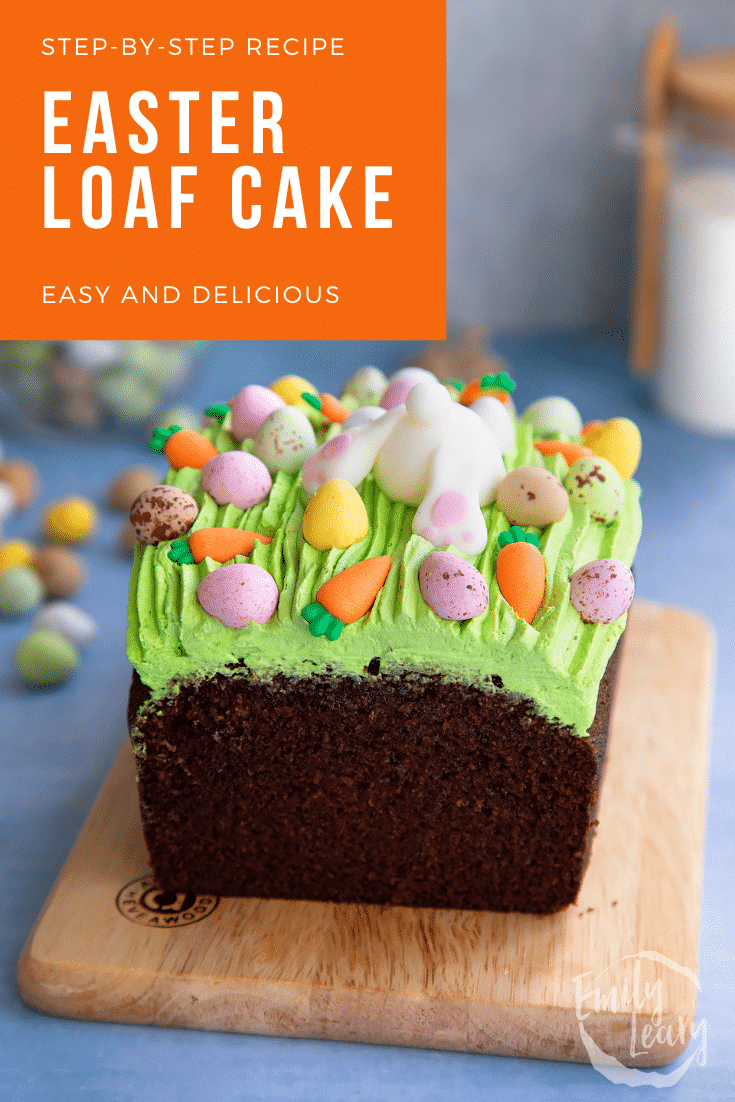
More easter recipes to try
Have you got my book?

'This is a great kids cookery book. Emily is a star' - Simon Rimmer
'The book I'd like to force into any mother's kitchen' - Prue Leith
"A fab book with a plan." - Jane Devonshire, 2016 Masterchef UK winner
'Emily has managed to combine her mummy knowledge and passion for food to make a truly helpful and brilliant cookbook' - Priya Tew, RD, BSc (Hons), Msc
Get Your Kids to Eat Anything is an achievable 'how to' for parents in the battle to overcome picky eating and 'make new the norm'. Emily Leary's unique 5-phase programme looks at the issue of 'fussy eating' in a holistic way that links imagination with food, and which situates parents alongside - not in opposition to - their children.
.

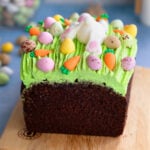
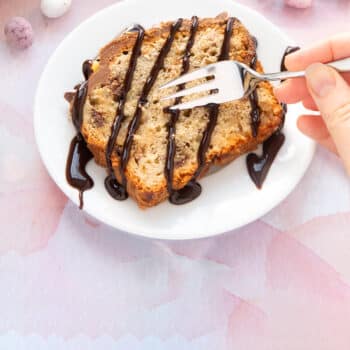
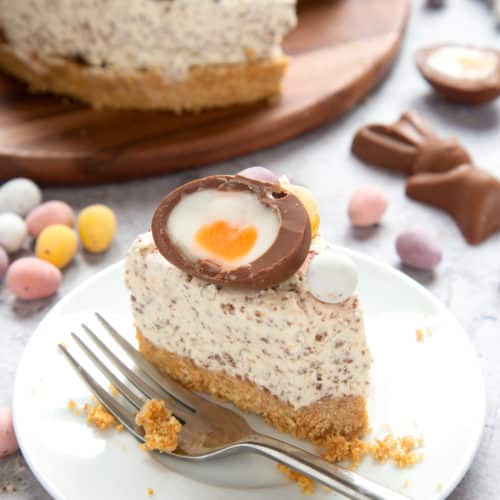


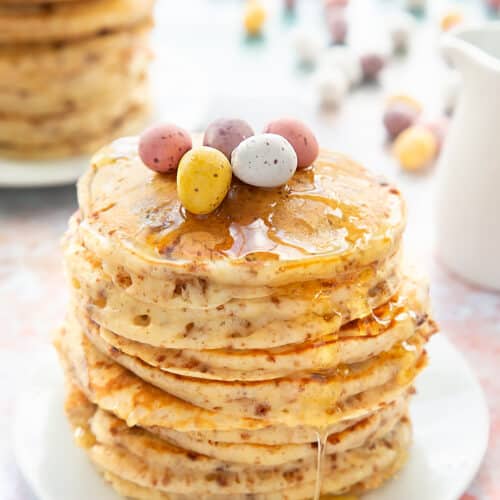
Leave a Reply